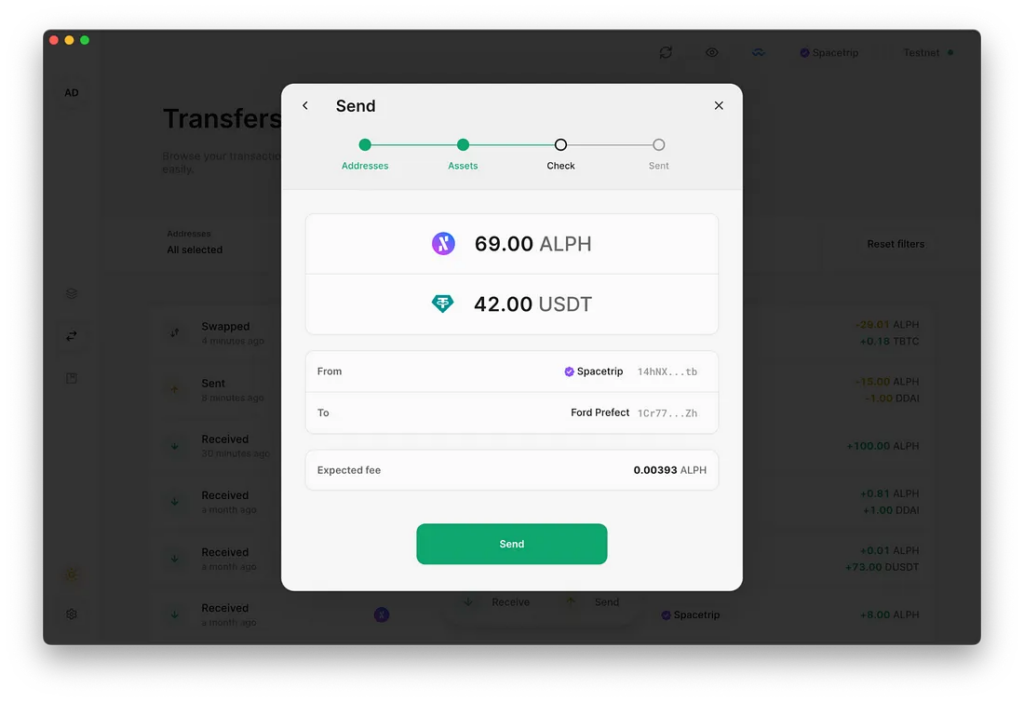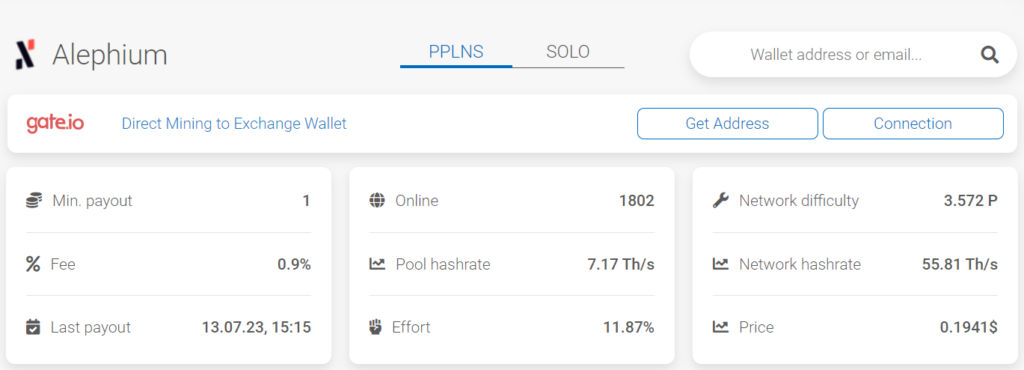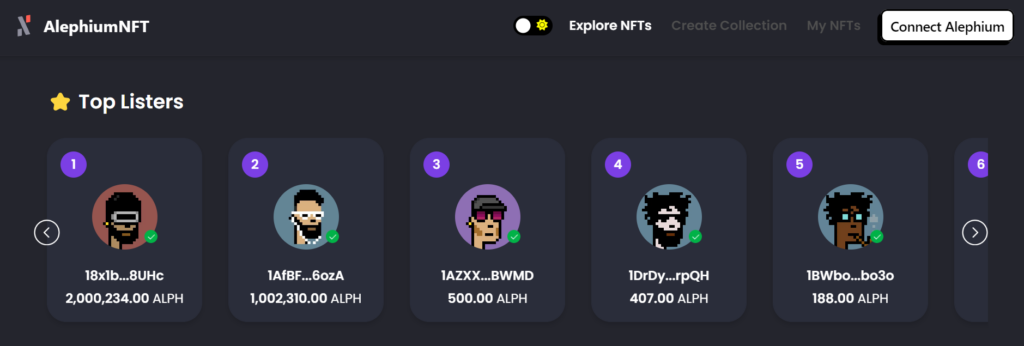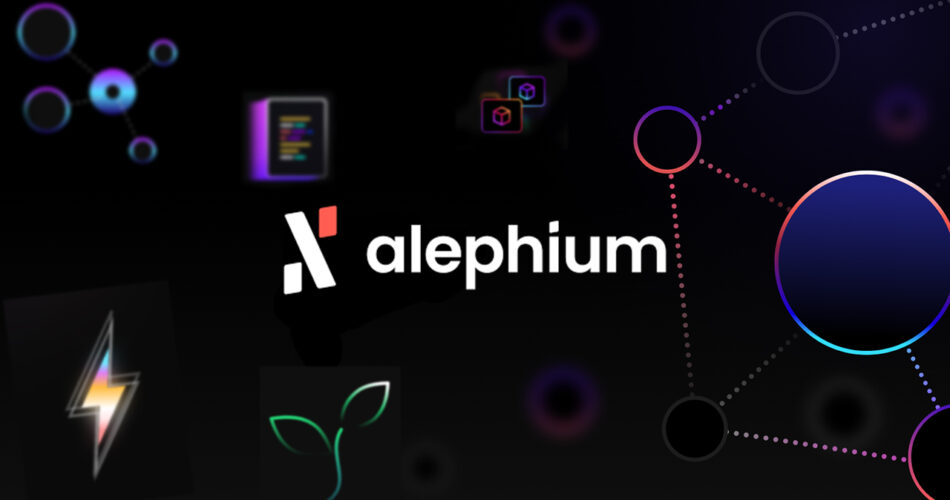In the ever-evolving world of cryptocurrencies, Alephium stands out as a unique and innovative player. This article will delve into the intricacies of Alephium, a sharded Layer 1 (L1) blockchain, and its significance in the crypto space.
Table of Contents
What is Alephium?
Alephium is a groundbreaking sharded L1 blockchain that scales and enhances Proof of Work (PoW) and Unspent Transaction Output (UTXO) concepts. It is a beacon of decentralization, self-sovereignty, and security, offering a high-performance, accessible, and energy-efficient network optimized for decentralized finance (DeFi) and smart contract applications.
Getting Started with Alephium
Alephium is not just a cryptocurrency; it’s a comprehensive platform that offers a range of opportunities for developers, contributors, and users alike. Here’s how you can get started with Alephium:
Building on Alephium
Alephium provides a robust and user-friendly platform for developers to build their own smart contracts, decentralized apps, and protocols. The platform’s comprehensive documentation and supportive community make it easier for developers, even those new to blockchain development, to get started.
Developers can utilize Alephium’s unique features, such as its stateful UTXO model and BlockFlow sharding algorithm, to build scalable and efficient applications. Moreover, with Alephium’s own Alphred Virtual Machine and Ralph programming language, developers can create secure and efficient smart contracts with ease.
Contributing to Alephium
Alephium values its community and encourages active participation. By contributing to initiatives that bring value to the project, participants can receive rewards and grants. This could involve developing new features, improving existing ones, or helping to grow the Alephium community.
Contributors can apply for a grant to develop their own project on Alephium. This not only provides financial support but also helps to foster innovation within the Alephium ecosystem. By contributing, you can help shape the future of Alephium and play a part in its mission to revolutionize the blockchain space.
Unique Features of Alephium
Alephium is a unique player in the blockchain space, offering several distinctive features that enhance scalability, energy efficiency, and programmability. Let’s delve into these features in more detail:
Feature Chart
| Feature | Description | Impact |
|---|---|---|
| BlockFlow Sharding Algorithm | Alephium is built on a novel and complete sharding algorithm called BlockFlow. This algorithm improves on the UTXO model of Bitcoin to make it scalable and uses a Directed Acyclic Graph (DAG) data structure to reach consensus between different shards. | This allows for up to 10,000 transactions per second, a significant improvement over Bitcoin’s 7 transactions per second. This scalability makes Alephium suitable for high-volume applications and transactions. |
| Efficiency in Energy Consumption | Alephium employs a unique concept called ‘Proof of Less Work’, which combines physical work and coin economics to dynamically adjust the work required to mine new blocks. | Given the same network conditions, Alephium uses ~90% less energy compared to Bitcoin. This energy efficiency makes Alephium a more sustainable choice in the crypto space. |
| Stateful UTXO Model and Programmability | Alephium introduces the stateful UTXO model that offers layer-1 scalability and a high level of programmability, similar to the account model used on Ethereum, but with enhanced security. | This feature allows developers to build more complex and secure applications on Alephium, expanding the possibilities for DeFi and smart contract applications. |
| Alphred Virtual Machine and Ralph Programming Language | Alephium’s Alphred Virtual Machine solves many of the critical issues of the current dApps platforms with huge improvements on security and development experience. Alephium’s programming language, Ralph, has a syntax inspired by the Rust programming language. | It allows for building efficient and secure smart contracts easily. It’s specifically designed to facilitate the creation of DeFi dApps, making Alephium a preferred choice for developers in the crypto space. |
Alephium’s Ecosystem
Alephium’s ecosystem is a vibrant and rapidly growing network of partners, backers, and community projects, all contributing to the development and expansion of the platform. This ecosystem is not just about the technology but also about the people and organizations that support and believe in Alephium’s vision.
Partners
Alephium’s partners range from legal firms to peer blockchains, local associations, and more. These partnerships help Alephium to navigate the complex landscape of blockchain technology and regulations. Some of the notable partners include the Bitcoin Association Switzerland, Crypto Valley Association, and Dappnode, among others. These partnerships ensure that Alephium is part of a larger ecosystem, contributing to and benefiting from the collective knowledge and resources.
Backers
Alephium has received early backing, funding, strategic advice, and more from a diverse group of backers. These include Alphemy Capital, Cetacean Capital, White Paper Capital, Archery Fund, and over 80 private individuals. This backing has provided Alephium with the necessary resources to develop and grow its platform.
Milestones and Future Plans
Alephium’s ecosystem is not static; it’s continuously evolving. The platform has achieved several milestones, including the public release of its whitepapers, the launch of its testnet and mainnet, the public release of its desktop wallet and explorer, and the listing on exchanges like Gate.io and Bitmart.
Looking ahead, Alephium has ambitious plans for the future. These include the launch of a mobile wallet, the introduction of Alephium Improvement Proposals (AIP), the launch of a grant program, and the integration with third-party wallets, among others. These plans indicate Alephium’s commitment to continuous improvement and innovation.
Alephium Price, Tokenomics, and Block
Max Supply
The maximum supply of ALPH tokens is capped at 1,000,000,000. This is the total number of ALPH tokens that will ever exist. This fixed supply model is similar to Bitcoin and many other cryptocurrencies, and it’s designed to create scarcity, which can contribute to the token’s value over time.
Coins in Block
Each block on the Alephium blockchain rewards miners with 2.73 ALPH tokens. This reward is given to the miner who successfully adds a new block to the blockchain by solving a complex mathematical problem, a process known as Proof of Work (PoW). This reward mechanism incentivizes miners to contribute their computational resources to the network, which helps secure the blockchain and validate transactions.
Time per Block
The Alephium blockchain is designed to produce a new block approximately every 64 seconds. This is significantly faster than Bitcoin, which aims for a block time of 10 minutes. The faster block time of Alephium allows for quicker transaction confirmations, making the blockchain more efficient for users.
Alephium Wallets

In the world of cryptocurrencies, wallets play a crucial role. They are the tools that allow users to manage their digital assets securely and conveniently. Alephium offers a variety of wallets to cater to different user needs. Let’s delve into the details:
Desktop Wallet
Alephium’s desktop wallet is designed for those who prefer to manage their digital assets on a computer. It offers a user-friendly interface that makes it easy to send, receive, and store Alephium tokens. The desktop wallet also provides advanced features for more experienced users, such as the ability to manage multiple addresses and view transaction history in detail.

Extension Wallet

For those who prefer to manage their digital assets while browsing the web, Alephium offers an extension wallet. This wallet can be added to your browser (Chrome or Firefox) and allows you to interact with Alephium-enabled websites directly. It’s perfect for those who want to use Alephium for decentralized apps (dApps) and other web-based services.
Mobile Wallet
Alephium is also developing a mobile wallet, which will allow users to manage their Alephium tokens on the go. The mobile wallet will offer the same features as the desktop and extension wallets, but in a format that’s optimized for mobile devices. This wallet is not yet available, but it’s part of Alephium’s future plans.
All of Alephium’s wallets are designed with a focus on security and ease-of-use. They provide users with full control over their private keys, ensuring that they are the only ones who can access their digital assets. Furthermore, the wallets are designed to be easy to use, even for those who are new to cryptocurrencies. This makes Alephium’s technology accessible to all, regardless of their level of experience with blockchain technology.
Alephium Mining

Alephium mining is a process that allows users to earn Alephium (ALPH) coins by contributing their computational power to the network. This process involves solving complex mathematical problems, which in turn helps to secure the network and validate transactions. Here’s a brief guide on how to get started with Alephium mining:
Preparation
Before you start mining, you need to have a wallet to store your Alephium coins. You can get a wallet from the section above or the Gate.io exchange. Make sure your wallet address starts with the number 1.
Mining Software
You will need mining software to mine Alephium. You can use Trex / Lolminer for Nvidia graphics cards and Lolminer / Srbminer for AMD graphics cards. Once you have downloaded and unzipped the miner, you will find a .bat file with the name Alph in it. Replace the existing wallet address in the .bat file with your own wallet address.
Or creat a flight sheet if you are running HiveOS / RaveOS.
Mining Pool

A mining pool is a group of miners who combine their computational resources to increase their chances of earning rewards. For Alephium mining, the recommended pool is pool.eu.woolypooly.com:3106. This pool has a low ping, low commission (only 0.9%), and a supportive community.
Running the Miner
Once you have set up your wallet, downloaded the miner, and chosen a mining pool, you can start mining. To do this, simply double-click on the .bat file. You should then see your worker or mining rig appear on the pool’s website.
Checking Your Earnings
You can check your earnings by entering your wallet address on the pool’s website. As you find blocks, your balance will increase. Once you reach the minimum payout amount, the tokens will automatically be sent to your wallet.
Overclocking
Overclocking your graphics card can help you increase your mining performance.
Alephium NFT Marketplace

Alephium’s NFT Marketplace is a vibrant platform where users can trade Non-Fungible Tokens (NFTs). The marketplace is available on the Alephium testnet and can be accessed here. The marketplace showcases a variety of NFTs, including digital art, collectibles, and more.
How to Use Alephium NFT Marketplace
To get started with the Alephium NFT Marketplace, you need to follow a few steps. Detailed instructions can be found on the Alephium NFT GitHub page, but here’s a brief overview:
- Installation: You need to have yarn installed on your system. If not, you can install it using the command
yarn. - Running the Development Server: You can start the development server using the command
yarn run dev. - Testing Smart Contracts: You can test smart contracts using the command
yarn run test:contracts. If you want to test a specific contract, you can do so by using the commandyarn run test:contracts -- nft-marketplace.test.ts. - Deploying Smart Contracts: Before running the application, you need to create two smart contracts: a marketplace smart contract for trading NFTs and a default NFT collection smart contract. You can deploy these contracts using the command
yarn run deploy:contracts. - Configuring Environments: There are two environments available during development:
development-nodewalletandbrowser-extension. In thedevelopment-nodewalletenvironment, node wallet is used as a signer for authentication and signing transactions. In thebrowser-extensionenvironment, Wallet Connect is used instead. You can switch between these environments by updating theENVIRONMENTvariable in thenext.config.jsfile.
Once you’ve followed these steps, you should be able to use the Alephium NFT Marketplace. Remember, this is a testnet, so it’s a safe environment to experiment and learn how to use the marketplace before it goes live on the mainnet.
Community Involvement

Alephium’s community is growing fast, with numerous opportunities for individuals to learn, build, and contribute. The community’s active involvement is a testament to Alephium’s potential in the crypto space.
Contributors can apply for a grant to develop their own project on Alephium. This not only provides financial support but also helps to foster innovation within the Alephium ecosystem. By contributing, you can help shape the future of Alephium and play a part in its mission to revolutionize the blockchain space.
Community projects are the lifeblood of Alephium. These projects, which are built on top of, around, or below Alephium’s platform, secure the network and provide services. They include Sezame Wallet, WoolyPooly, and Sahhar Wallet. These projects demonstrate the versatility of Alephium’s platform and the creativity of its community.
Here are the community links for Alephium:
Alephium Team
🤯 Happening right now: Internal tech conference on Blockflow, #Alephium's sharding algorithm! 🤯 pic.twitter.com/HJl64tkMti
— Alephium (@alephium) May 4, 2023
- Maud Bannwart – Chief Operating Officer at Alephium
- Maud has been with Alephium since June 2021.
- Prior to Alephium, she founded Outsight Solutions in December 2020, providing HR and Operations advisory services to tech startups and SMEs.
- She also served as an Operations Consultant at Bestmile for 5 months in 2021, where she replaced the company’s Co-Founder and COO during her maternity leave.
- Before that, she was the Global Head of HR at Lykke for almost 3 years, where she structured and implemented the full HR function from scratch for a team of over 200 members across 20 countries.
- Alexandre Poltorak – Legal & Strategy Advisor at Alephium
- Alexandre has been with Alephium since November 2021.
- He is also the Co-Founder of Hodling SA, a company providing non-custodial bitcoin storage solutions for owners of large bitcoin balances.
- He has been the owner and director of Alsenet SA for over 24 years.
- He also serves as the Marketing Director for Elphel, Inc. and is a member of the Board of Trustees for the Olanto Foundation.
- Cheng Wang – Founder at Alephium
- Cheng founded Alephium in September 2018.
- Prior to Alephium, he was a Senior Data Scientist at Swisscom for 11 months.
- Before that, he was an Algorithm Researcher and Software Engineer at Bestmile for over a year, where he developed core algorithms for autonomous vehicles.
- He also served as a Research Assistant at the Ecole polytechnique fédérale de Lausanne (EPFL) for over 2 years, focusing on the theory and application of distributed computing.
- He was also a Research Assistant at the Institute of Computing Technology, Chinese Academy of Sciences for 9 months, researching on DNA assembly.
These profiles provide a glimpse into the diverse backgrounds and extensive experience of the Alephium team, which includes expertise in operations, legal and strategy, HR, data science, algorithm research, and distributed computing.
Conclusion
Alephium stands out in the crypto space due to its innovative features, including its BlockFlow sharding algorithm, stateful UTXO model, and Alphred Virtual Machine and Ralph programming language. These features enhance scalability, energy efficiency, and programmability, making Alephium suitable for high-volume applications and transactions, and a preferred choice for developers in the crypto space.
Alephium is not just a cryptocurrency; it’s a comprehensive platform that offers a range of opportunities for developers, contributors, and users alike. It has a vibrant and rapidly growing ecosystem of partners, backers, and community projects, all contributing to the development and expansion of the platform. Alephium has also achieved several milestones, including the public release of its whitepapers, the launch of its testnet and mainnet, the public release of its desktop wallet and explorer, and the listing on exchanges like Gate.io and Bitmart.
In conclusion, Alephium is a groundbreaking sharded L1 blockchain that scales and enhances Proof of Work (PoW) and Unspent Transaction Output (UTXO) concepts. It offers a high-performance, accessible, and energy-efficient network optimized for decentralized finance (DeFi) and smart contract applications. With its unique features and growing ecosystem, Alephium is shaping the future of the crypto space.
FAQs
What is Alephium?
Alephium is a sharded Layer 1 (L1) blockchain that enhances and scales Proof of Work (PoW) and Unspent Transaction Output (UTXO) concepts. It offers a high-performance, accessible, and energy-efficient network optimized for decentralized finance (DeFi) and smart contract applications.
How to mine Alephium?
To mine Alephium, you need to have a wallet to store your Alephium coins. You can use mining software like Trex / Lolminer for Nvidia graphics cards and Lolminer / Srbminer for AMD graphics cards. Once you have downloaded and unzipped the miner, you will find a .bat file with the name Alph in it. Replace the existing wallet address in the .bat file with your own wallet address. For Alephium mining, the recommended pool is pool.eu.woolypooly.com:3106. Once you have set up your wallet, downloaded the miner, and chosen a mining pool, you can start mining.
Where to buy and sell Alephium?
Alephium can be bought and sold on cryptocurrency exchanges like Gate.io. You would need to create an account, deposit funds, and then you can proceed to buy or sell Alephium (ALPH) coins.


